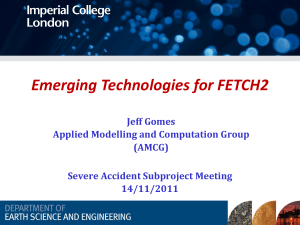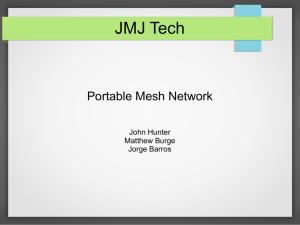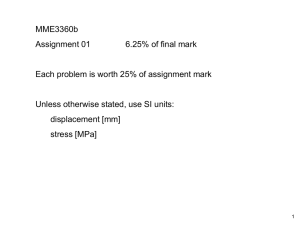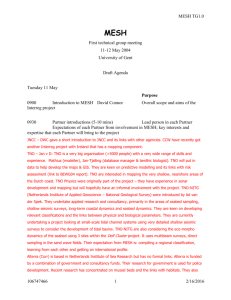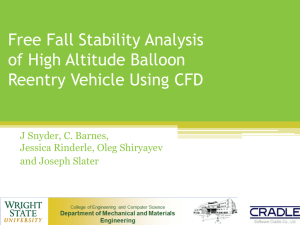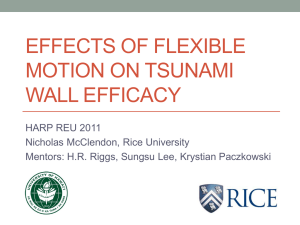TechQuest_SaudiAramco2011
advertisement
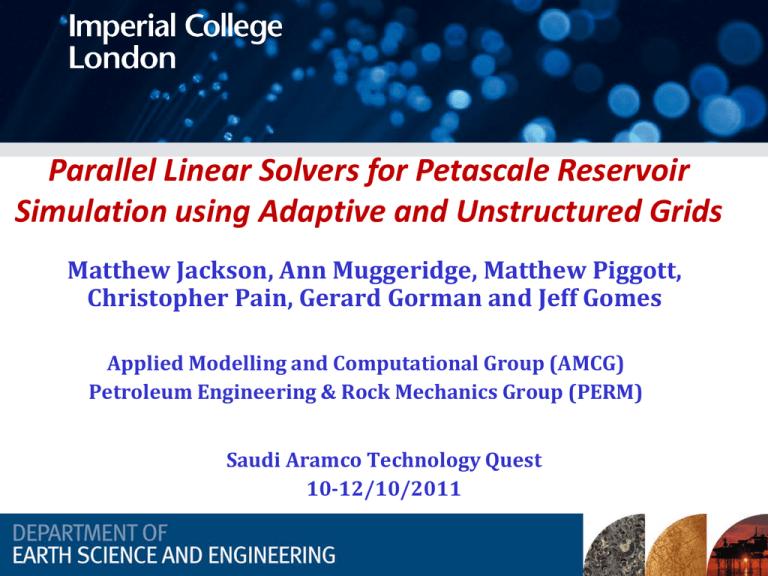
Parallel Linear Solvers for Petascale Reservoir Simulation using Adaptive and Unstructured Grids Matthew Jackson, Ann Muggeridge, Matthew Piggott, Christopher Pain, Gerard Gorman and Jeff Gomes Applied Modelling and Computational Group (AMCG) Petroleum Engineering & Rock Mechanics Group (PERM) Saudi Aramco Technology Quest 10-12/10/2011 Leading team with the breadth of skills Imperial College: Leading university – strong in Engineering. AMCG & PERM within ESE: Leading modelling and reservoir physics groups – largest university research group in the UK and winner of the Imperial College Research Excellence Award. Developed major models e.g. the Imperial College Ocean Model as the next gen. Ocean model for the UK and Internationally. The team: • Prof Matt Jackson: Reservoir characterisation and engineering • Prof Ann Muggeridge: Reservoir physics, EOR • Prof Chris Pain: Adaptive meshes, linear solvers, discretisation • Dr Matt Piggott: Geophysical CFD • Dr Gerard Gorman: HPC, mesh generation • Dr Jeff Gomes: Multi-physics CFD modelling Technology Quest Development of computational technologies that enable detailed multi-scale simulations of fluid flows in giant oil and gas fields. How we will tackle this Tech Quest We will develop the following modular technologies that may be integrated into Saudi Aramco simulator: Petascale linear solvers for multi-scale reservoir simulations with high aspect ratio elements/cells building on open-source code. Numerical dynamic core for multiphase flow on unstructured adaptive meshes that are accurate (exact). Demonstration through simulations of fluid flow in giant oil and gas fields. CFD Modelling: Parallel Anisiotropic Mesh Adaptivity and Domain Decomposition Adaptive Mesh and Petascale Solvers Movie Page 6 CFD Modelling: Parallel Mesh Adaptivity - Parallel Scaling Adaptive Mesh and Petascale Solvers Parallel adaptive mesh technology – world leading. Unique high aspect ratio multi-grid solvers. Front runner in GFD. AMCG and Fujitsu are enhancing the adaptive mesh library as part of their Open Petascale Libraries (OPL) initiative (MPI/OpenMP). On-going collaboration with Argonne National Lab on hybridizing (MPI/OpenMP) PETSc libraries. Maintained by NAG. AMCG, Fujitsu, Dainsbury and EPCC: collaboration on HPC and mesh adaptivity to scale > 100K cores: better able to exploit memory hierarchy. Numerical Dynamic Core Development of novel family of tetrahedral elements. P1DGP2 + overlapping elements have unique abilities to represent key force balances on unstructured mesh e.g. Darcy’s Law & hydrostatic pressure. Exact force balance with only approximation in advection – limited CV-DG or CVFEM and implicit time stepping Compositional modelling. Technology Transfer : Training, Dissemination & Communication with Saudi-Aramco Train PDRAs and PhD students for the future e.g. for Saudi Aramco. Intensive established training events and workshops on methods, use of models, how to develop code & physics. Joint workshops, exchange visits and placements. Software: Manual, Visualization, Management (regression testing, IRC chat, bug and issue tracking, code management). Page 10 Added value and future work To develop the following modular technologies to be integrated into Saudi Aramco simulator: Hiding the details of the hardware that the model is run on e.g. GPUs. Predictive modelling (adjoints, EnKF, reduced order modelling, sensitivity analysis, adaptive observations, data assimilation, uncertainty). Cross fertilization with other disciplines. Summary Looking for long term strategic partnership in reservoir simulators. Will develop key components of a next-generation simulator. Parallel mesh adaptivity will be a key aspect of a future multiscale simulator. Dynamic core that can represent physics accurately on meshes is essential. A Few Backup Slides Conservative Interpolation: Crucial for many applications, with Adaptivity, Coupled models ‘donor’ mesh ‘target’ mesh ‘super mesh’ and mapping from donor mesh Following Page construction 15of the supermesh we are able to perform projection operations to achieve conservative, bounded (etc…) interpolation schemes. 2D: Farrell et al., 2009 3D: Farrell, Maddison, 2009 Immersed-Body Method (Fluid-Solid Interaction Modelling) Mesh Adaptivity and Domain Decomposition Lower frame shows the domain decomposition which has been optimised to balance the load based on number of nodes and minimised edge cut Applications: Surface-based reservoir modelling Applications: Surface-based reservoir modelling

